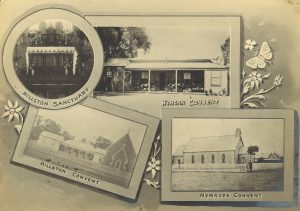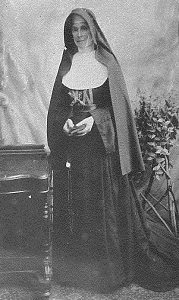Sisters of the Diocese of Wilcannia Amalgamate with North Sydney Josephites
Among the many twists of history and blessings of divine providence associated with the Sisters of Saint Joseph, is the story of those sisters who were appointed from The Vale (Perthville) to several small towns in western New South Wales. This is their story.

From the time of the first foundation from The Vale to the remote town of Bourke, the sisters in the western part of the state experienced extreme isolation. That community did not return to The Vale for the summer holiday for three and a half years after the foundation was made in 1881. After Nyngan was opened the two convents naturally formed their own group that later expanded to include Nymagee and Balranald. Far removed from the authority of the bishop of Bathurst and the sister guardian at The Vale, the “western group” lived according to the early traditions of the Institute, and directives, if indeed they reached the area, were generally only taken up if they were consistent with those traditions. Prior to his death in 1889, a number of the sisters had maintained a regular correspondence with Father Woods for whom they held a deep affection. In many instances the Book of Instructions, prohibited at The Vale, was carefully followed.
When the diocese of Wilcannia was constituted in 1887 under the leadership of Bishop Dunne, those sisters already working in the area remained there forming their own diocesan Institute separate from The Vale. Sister Stanislaus Fitzpatrick was appointed sister guardian by the bishop who made it clear that he wished the sisters under his authority to observe the Rule, custom and directives issued from Perthville.. However, life in the convents went on much the same as prior to the arrival of the new bishop.
In 1891 the Sisters of Saint Joseph left Bourke and were replaced by the Sisters of Mercy who were able to provide secondary education which by that time was required by a number of Bourke students. Hillston was then chosen as the mother house of the Sisters of Saint Joseph. At the conclusion of that year, Sister Ursula Dunning was appointed sister guardian after Stanislaus Fitzpatrick had resigned due to ill health. Balranald was also given into the care of the Sisters of Mercy.

Isolated and without much expectation of expansion, the small diocesan Institute of Josephites continued in just three centres. They felt their isolation very keenly. Some were in poor health and others required attention for their eyesight that had been neglected. In Nymagee two of their number died. Sister Aloysius Kelly was only twenty-eight when she died of tuberculosis in 1890. Sister Ambrose Sullivan was the same age when she died in 1894 of typhoid fever. There was nowhere the Sisters could escape the heat during the summer holiday. They recognised their need for sound professional training and ongoing spiritual formation if they were to be a viable religious Institute. Furthermore, the revised Rule, which one of the sisters saw by chance, required changes that they had already found unacceptable.
However, that sighting and presumably some contact with other diocesan groups, made the sisters of the Wilcannia diocese aware that according to the terms of the 1888 decree from Rome, they were free to either remain under the authority of the bishop or to join with the Sydney Josephites. By August 1899, they had initiated moves to amalgamate, stating to Mother Mary MacKillop their desire “to establish on a firm footing the spirit of our early sisters of whom you were the first.” (Sister Margaret Mary Lyons to Mother Mary MacKillop 28.5.1901).
After Bishop Dunne’s return from Rome and negotiations that included the continuing presence of the sisters in the Wilcannia diocese, arrangements went ahead. Sister Joseph Dwyer, who had played a significant part in the withdrawal of the sisters from The Vale in 1876, visited each community on behalf of Mother Mary. A total of twenty-one sisters, the majority of whom had begun their religious life at The Vale, were part of the amalgamation that was finally completed on 2 December 1902. At some time prior to that, the four sisters who desired to maintain diocesan status returned to The Vale.
In recent years the Perthville Sisters and the local Nymagee Catholic community have seen to the restoration of the two Josephite graves in the Nymagee cemetery. On 28 November 2001, a group of the sisters, together with the community, gathered there for a ceremony of rededication of the graves. The memorial plaque which was erected on the site on that day bears witness to the small band of Sisters of Saint Joseph who served so courageously and generously in the western areas of New South Wales.
Marie Crowley PhD
